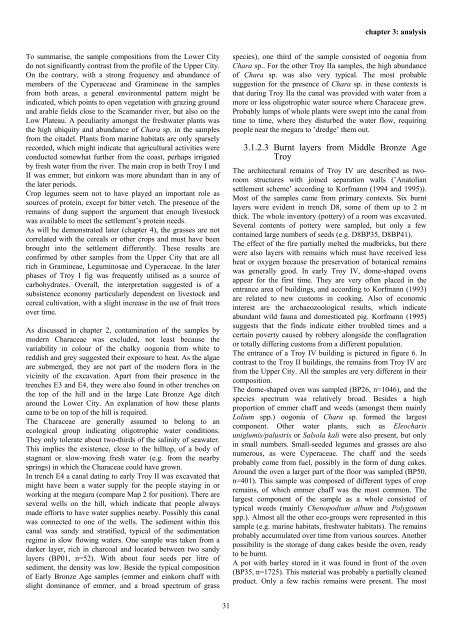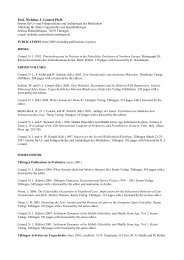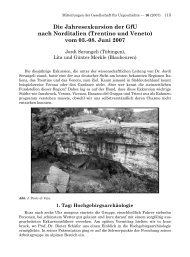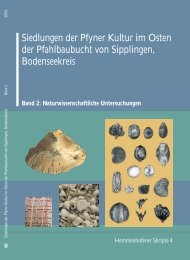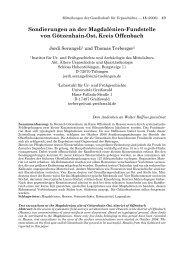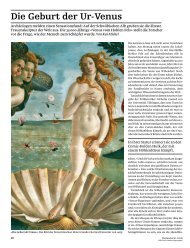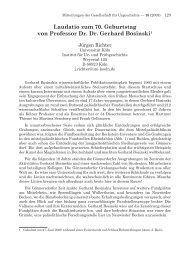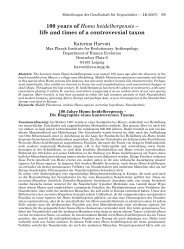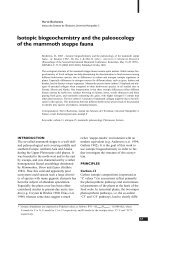bronze age environment and economy in the troad - Universität ...
bronze age environment and economy in the troad - Universität ...
bronze age environment and economy in the troad - Universität ...
You also want an ePaper? Increase the reach of your titles
YUMPU automatically turns print PDFs into web optimized ePapers that Google loves.
chapter 3: analysis<br />
To summarise, <strong>the</strong> sample compositions from <strong>the</strong> Lower City<br />
do not significantly contrast from <strong>the</strong> profile of <strong>the</strong> Upper City.<br />
On <strong>the</strong> contrary, with a strong frequency <strong>and</strong> abundance of<br />
members of <strong>the</strong> Cyperaceae <strong>and</strong> Gram<strong>in</strong>eae <strong>in</strong> <strong>the</strong> samples<br />
from both areas, a general <strong>environment</strong>al pattern might be<br />
<strong>in</strong>dicated, which po<strong>in</strong>ts to open vegetation with graz<strong>in</strong>g ground<br />
<strong>and</strong> arable fields close to <strong>the</strong> Scam<strong>and</strong>er river, but also on <strong>the</strong><br />
Low Plateau. A peculiarity amongst <strong>the</strong> freshwater plants was<br />
<strong>the</strong> high ubiquity <strong>and</strong> abundance of Chara sp. <strong>in</strong> <strong>the</strong> samples<br />
from <strong>the</strong> citadel. Plants from mar<strong>in</strong>e habitats are only sparsely<br />
recorded, which might <strong>in</strong>dicate that agricultural activities were<br />
conducted somewhat fur<strong>the</strong>r from <strong>the</strong> coast, perhaps irrigated<br />
by fresh water from <strong>the</strong> river. The ma<strong>in</strong> crop <strong>in</strong> both Troy I <strong>and</strong><br />
II was emmer, but e<strong>in</strong>korn was more abundant than <strong>in</strong> any of<br />
<strong>the</strong> later periods.<br />
Crop legumes seem not to have played an important role as<br />
sources of prote<strong>in</strong>, except for bitter vetch. The presence of <strong>the</strong><br />
rema<strong>in</strong>s of dung support <strong>the</strong> argument that enough livestock<br />
was available to meet <strong>the</strong> settlement’s prote<strong>in</strong> needs.<br />
As will be demonstrated later (chapter 4), <strong>the</strong> grasses are not<br />
correlated with <strong>the</strong> cereals or o<strong>the</strong>r crops <strong>and</strong> must have been<br />
brought <strong>in</strong>to <strong>the</strong> settlement differently. These results are<br />
confirmed by o<strong>the</strong>r samples from <strong>the</strong> Upper City that are all<br />
rich <strong>in</strong> Gram<strong>in</strong>eae, Legum<strong>in</strong>osae <strong>and</strong> Cyperaceae. In <strong>the</strong> later<br />
phases of Troy I fig was frequently utilised as a source of<br />
carbohydrates. Overall, <strong>the</strong> <strong>in</strong>terpretation suggested is of a<br />
subsistence <strong>economy</strong> particularly dependent on livestock <strong>and</strong><br />
cereal cultivation, with a slight <strong>in</strong>crease <strong>in</strong> <strong>the</strong> use of fruit trees<br />
over time.<br />
As discussed <strong>in</strong> chapter 2, contam<strong>in</strong>ation of <strong>the</strong> samples by<br />
modern Characeae was excluded, not least because <strong>the</strong><br />
variability <strong>in</strong> colour of <strong>the</strong> chalky oogonia from white to<br />
reddish <strong>and</strong> grey suggested <strong>the</strong>ir exposure to heat. As <strong>the</strong> algae<br />
are submerged, <strong>the</strong>y are not part of <strong>the</strong> modern flora <strong>in</strong> <strong>the</strong><br />
vic<strong>in</strong>ity of <strong>the</strong> excavation. Apart from <strong>the</strong>ir presence <strong>in</strong> <strong>the</strong><br />
trenches E3 <strong>and</strong> E4, <strong>the</strong>y were also found <strong>in</strong> o<strong>the</strong>r trenches on<br />
<strong>the</strong> top of <strong>the</strong> hill <strong>and</strong> <strong>in</strong> <strong>the</strong> large Late Bronze Age ditch<br />
around <strong>the</strong> Lower City. An explanation of how <strong>the</strong>se plants<br />
came to be on top of <strong>the</strong> hill is required.<br />
The Characeae are generally assumed to belong to an<br />
ecological group <strong>in</strong>dicat<strong>in</strong>g oligotrophic water conditions.<br />
They only tolerate about two-thirds of <strong>the</strong> sal<strong>in</strong>ity of seawater.<br />
This implies <strong>the</strong> existence, close to <strong>the</strong> hilltop, of a body of<br />
stagnant or slow-mov<strong>in</strong>g fresh water (e.g. from <strong>the</strong> nearby<br />
spr<strong>in</strong>gs) <strong>in</strong> which <strong>the</strong> Characeae could have grown.<br />
In trench E4 a canal dat<strong>in</strong>g to early Troy II was excavated that<br />
might have been a water supply for <strong>the</strong> people stay<strong>in</strong>g <strong>in</strong> or<br />
work<strong>in</strong>g at <strong>the</strong> megara (compare Map 2 for position). There are<br />
several wells on <strong>the</strong> hill, which <strong>in</strong>dicate that people always<br />
made efforts to have water supplies nearby. Possibly this canal<br />
was connected to one of <strong>the</strong> wells. The sediment with<strong>in</strong> this<br />
canal was s<strong>and</strong>y <strong>and</strong> stratified, typical of <strong>the</strong> sedimentation<br />
regime <strong>in</strong> slow flow<strong>in</strong>g waters. One sample was taken from a<br />
darker layer, rich <strong>in</strong> charcoal <strong>and</strong> located between two s<strong>and</strong>y<br />
layers (BP01, n=52). With about four seeds per litre of<br />
sediment, <strong>the</strong> density was low. Beside <strong>the</strong> typical composition<br />
of Early Bronze Age samples (emmer <strong>and</strong> e<strong>in</strong>korn chaff with<br />
slight dom<strong>in</strong>ance of emmer, <strong>and</strong> a broad spectrum of grass<br />
species), one third of <strong>the</strong> sample consisted of oogonia from<br />
Chara sp.. For <strong>the</strong> o<strong>the</strong>r Troy IIa samples, <strong>the</strong> high abundance<br />
of Chara sp. was also very typical. The most probable<br />
suggestion for <strong>the</strong> presence of Chara sp. <strong>in</strong> <strong>the</strong>se contexts is<br />
that dur<strong>in</strong>g Troy IIa <strong>the</strong> canal was provided with water from a<br />
more or less oligotrophic water source where Characeae grew.<br />
Probably lumps of whole plants were swept <strong>in</strong>to <strong>the</strong> canal from<br />
time to time, where <strong>the</strong>y disturbed <strong>the</strong> water flow, requir<strong>in</strong>g<br />
people near <strong>the</strong> megara to ‛dredge’ <strong>the</strong>m out.<br />
3.1.2.3 Burnt layers from Middle Bronze Age<br />
Troy<br />
The architectural rema<strong>in</strong>s of Troy IV are described as tworoom<br />
structures with jo<strong>in</strong>ed separation walls (‛Anatolian<br />
settlement scheme’ accord<strong>in</strong>g to Korfmann (1994 <strong>and</strong> 1995)).<br />
Most of <strong>the</strong> samples came from primary contexts. Six burnt<br />
layers were evident <strong>in</strong> trench D8, some of <strong>the</strong>m up to 2 m<br />
thick. The whole <strong>in</strong>ventory (pottery) of a room was excavated.<br />
Several contents of pottery were sampled, but only a few<br />
conta<strong>in</strong>ed large numbers of seeds (e.g. D8BP35, D8BP41).<br />
The effect of <strong>the</strong> fire partially melted <strong>the</strong> mudbricks, but <strong>the</strong>re<br />
were also layers with rema<strong>in</strong>s which must have received less<br />
heat or oxygen because <strong>the</strong> preservation of botanical rema<strong>in</strong>s<br />
was generally good. In early Troy IV, dome-shaped ovens<br />
appear for <strong>the</strong> first time. They are very often placed <strong>in</strong> <strong>the</strong><br />
entrance area of build<strong>in</strong>gs, <strong>and</strong> accord<strong>in</strong>g to Korfmann (1993)<br />
are related to new customs <strong>in</strong> cook<strong>in</strong>g. Also of economic<br />
<strong>in</strong>terest are <strong>the</strong> archaeozoological results, which <strong>in</strong>dicate<br />
abundant wild fauna <strong>and</strong> domesticated pig. Korfmann (1995)<br />
suggests that <strong>the</strong> f<strong>in</strong>ds <strong>in</strong>dicate ei<strong>the</strong>r troubled times <strong>and</strong> a<br />
certa<strong>in</strong> poverty caused by robbery alongside <strong>the</strong> conflagration<br />
or totally differ<strong>in</strong>g customs from a different population.<br />
The entrance of a Troy IV build<strong>in</strong>g is pictured <strong>in</strong> figure 6. In<br />
contrast to <strong>the</strong> Troy II build<strong>in</strong>gs, <strong>the</strong> rema<strong>in</strong>s from Troy IV are<br />
from <strong>the</strong> Upper City. All <strong>the</strong> samples are very different <strong>in</strong> <strong>the</strong>ir<br />
composition.<br />
The dome-shaped oven was sampled (BP26, n=1046), <strong>and</strong> <strong>the</strong><br />
species spectrum was relatively broad. Besides a high<br />
proportion of emmer chaff <strong>and</strong> weeds (amongst <strong>the</strong>m ma<strong>in</strong>ly<br />
Lolium spp.) oogonia of Chara sp. formed <strong>the</strong> largest<br />
component. O<strong>the</strong>r water plants, such as Eleocharis<br />
uniglumis/palustris or Salsola kali were also present, but only<br />
<strong>in</strong> small numbers. Small-seeded legumes <strong>and</strong> grasses are also<br />
numerous, as were Cyperaceae. The chaff <strong>and</strong> <strong>the</strong> seeds<br />
probably come from fuel, possibly <strong>in</strong> <strong>the</strong> form of dung cakes.<br />
Around <strong>the</strong> oven a larger part of <strong>the</strong> floor was sampled (BP50,<br />
n=401). This sample was composed of different types of crop<br />
rema<strong>in</strong>s, of which emmer chaff was <strong>the</strong> most common. The<br />
largest component of <strong>the</strong> sample as a whole consisted of<br />
typical weeds (ma<strong>in</strong>ly Chenopodium album <strong>and</strong> Polygonum<br />
spp.). Almost all <strong>the</strong> o<strong>the</strong>r eco-groups were represented <strong>in</strong> this<br />
sample (e.g. mar<strong>in</strong>e habitats, freshwater habitats). The rema<strong>in</strong>s<br />
probably accumulated over time from various sources. Ano<strong>the</strong>r<br />
possibility is <strong>the</strong> stor<strong>age</strong> of dung cakes beside <strong>the</strong> oven, ready<br />
to be burnt.<br />
A pot with barley stored <strong>in</strong> it was found <strong>in</strong> front of <strong>the</strong> oven<br />
(BP35, n=1725). This material was probably a partially cleaned<br />
product. Only a few rachis rema<strong>in</strong>s were present. The most<br />
31


